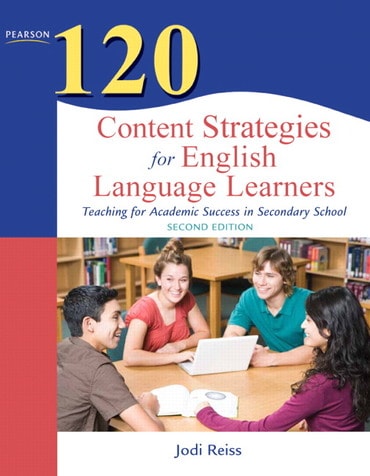
120 Content Strategies for English Language Learners: Teaching for Academic Success in Secondary School, 2nd edition
Published by Pearson (November 21, 2011) © 2012
- Jodi Reiss
Access details
- Instant access once purchased
- Fulfilled by VitalSource
- 180-day rental
Features
- Add notes and highlights
- Search by keyword or page
Access details
- Instant access once purchased
- Fulfilled by VitalSource
- 180-day rental
Features
- Add notes and highlights
- Search by keyword or page
Table of contents
Contents
Foreword: Ten Questions
Preface
Part I Perspectives for Classroom Practice: Theory and Culture
Chapter 1 Theoretical Considerations
Why Content Teachers Can Help
How Content Teachers Can Help
Theoretical Foundations
Cummins: Differentiation of Social and Academic Language
Krashen: The Affective Filter
Krashen: The Comprehensible Input Hypothesis
Vygotsky: Zone of Proximal Development
Swain: Meaningful Output
Brown: Principles of Language Teaching and Learning
Bloom: Taxonomy
Applying the Theories and Principles
Theory to Application: Twelve Guidelines for Practice
Questions for Discussion
References and Resources
Chapter 2 Culture and Content Instruction
Culture and the Process of Content Instruction
Class Work Patterns
Instructional Patterns
Questioning Patterns
Expressing Opinions
Response Time Patterns
Attention Patterns
Feedback Patterns
Patterns of Address
A Shift in Perception
Cultural Behaviors Change Slowly
Culture and the Product of Content Learning
Special Considerations for Teachers of Math
Special Considerations for Teachers of Science
Special Considerations for Teachers of Social Studies
Special Considerations for Teachers of Language Arts, Reading, and Literature
Questions for Discussion
References and Resources
Part II Strategies for Classroom Practice: Instruction
Chapter 3 Meeting State Objectives and Standards: Making Good Choices
Standards for English Language Learners
The Dilemma of Standards
Selecting Standards, Topics, and Objectives
The Objective: Analyze Standards, Topics, and Objectives to Make Sound Choices
In Summary: Selecting Standards, Topics, and Objectives
Questions for Discussion
References and Resources
Chapter 4 Learning Strategies for English Language Learners
Learning Strategies Defined
Learning Strategies and Teaching Strategies: Same or Different?
Learning Strategies and Learning Styles: Same or Different?
The Types of Learning Strategies
Metacognitive Strategies
Cognitive Strategies
Memory Strategies
Social Strategies
Compensation Strategies
Working with Learning Strategies
The Objective: Combine Strategies and Strategy Types
The Objective: Actively Teach Learning Strategies
In Summary: Working with Learning Strategies
Questions for Discussion
References and Resources
Chapter 5 A Solid Start: Building and Activating Background Knowledge
Motivation
Preexisting Knowledge
All Students Need Background Knowledge
Working with Background Knowledge
The Objective: Use Varied Techniques to Activate and Build Background Knowledge
In Summary: Working with Background Knowledge
Questions for Discussion
References and Resources
Chapter 6 Presenting New Material: Teaching the Lesson
Oral Academic Language
The Difficulties of Oral Academic Language
Teacher Talk
The Objective: Pace Your Speech
The Objective: Simplify Your Speech
The Objective: Enhance Your Words
Classroom Routine and Review
The Objective: Create Classroom Routines
The Objective: Get into the Routine of Review
In Summary: Teaching the Lesson
Questions for Discussion
References and Resources
Chapter 7 Did They Get What I Taught? Checking Comprehension
Questions, Answers, and Participation in the Classroom
The Objective: Formulate Questions in Ways that Encourage Participation
The Objective: Fine Tune Your Awareness of Student Participation
In Summary: Classroom Questions, Answers, and Participation
Questions for Discussion
References and Resources
Chapter 8 Extending Comprehension: Textbook Vocabulary Strategies
New Vocabulary: Which Words to Teach?
Synonyms
Idioms
New Usages of Familiar Words
Just Plain New Words
Teaching and Learning Vocabulary
The Objective: Use Meaningful Strategies for Teaching and Learning Vocabulary
The Objective: Integrate Vocabulary Development into Daily Instruction
In Summary: Teaching and Learning Vocabulary
Questions for Discussion
References and Resources
Chapter 9 Extending Comprehension: Textbook Reading Strategies
Working with Your Textbook
The Objective: Show Students How to Get the Most Out of Their Textbooks
The Objective: Help Students Become Competent Note Takers
The Objective: Use Alternative Resources for True ELL Beginners
In Summary: Working with Your Textbook
Questions for Discussion
References and Resources
Chapter 10 Reinforcing Learning: Activities and Assignments
Assignments to Promote Student Success
The Objective: Good Assignments Begin with Good Directions
The Objective: Modify Whole Class Assignments to Make Language Comprehensible
The Objective: Differentiate Instructional Activities and Assignments
In Summary: Assignments that Promote Student Success
Questions for Discussion
References and Resources
Part III Strategies for Classroom Practice: Assessment
Chapter 11 Classroom Assessments: Did They Learn What You Taught?
Essay Questions, Multiple-Choice Questions, and Language Demand
The Pitfalls of Multiple-Choice Tests
Separating Language from Content in Assessments
The Objective: Modify Testing Techniques
The Objective: Don’t Test at All!
The Objective: Grade English Language Learners to Promote Success
In Summary: Separating Language from Content in Assessment
Questions for Discussion
References and Resources
Chapter 12 The Big One: Preparing for High-Stakes Tests
Maximizing Student Potential on Standardized Tests
The Objective: Familiarize Students with the Format and Process of Multiple-choice Testing
The Objective: Use All Reasonable Allowable Accommodations for English Language Learners
In Summary: Maximizing Student Potential on Standardized Tests
Conclusion
Questions for Discussion
References and Resources
Glossary of Acronyms
Book Club Section
Appendix I Additional Resources for Teachers
